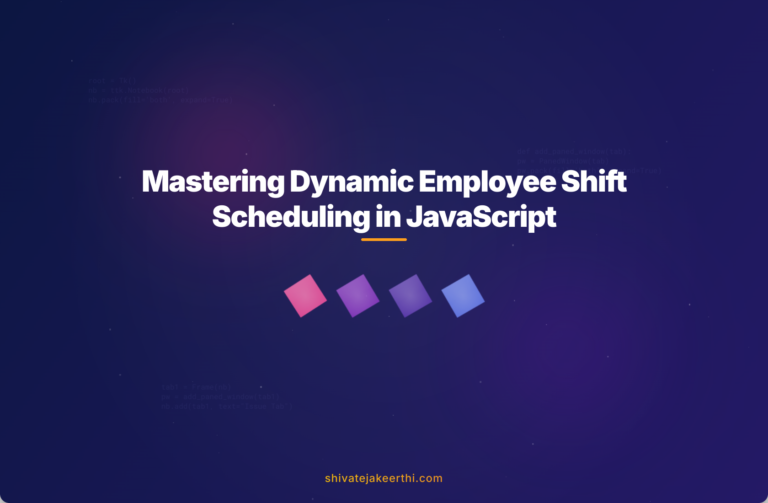Managing a scheduling system effectively often comes down to properly structuring your data. Whether you oversee a small team or a busy workplace, a well-designed structured array can simplify scheduling tasks, make updates easier, and ensure smooth workflows.
When scheduling, your data is always changing—staff shift rotations, vacations, sick days. That’s where dynamic data inserts come into play. They allow quick, efficient updates without overhauling your entire dataset.
In this guide, I’ll explain how you can easily build a structured array in JavaScript to manage your schedules, insert dynamic data inline, and follow best practices for efficient, robust scheduling management.
Setting Up the Initial Arrays
Let’s start by creating our base data arrays. Initially, you want arrays representing the days of the month and the day’s names.
Creating an array for days of the month is simple:
const array1 = Array.from({length: 31}, (_, i) => i + 1);
// Creates [1, 2, 3, ..., 31]
The above code uses JavaScript’s built-in Array.from method to quickly populate an array from values 1 through 31, each representing a day of the month.
Next, let’s add another array—names of the days:
const array2 = ["Mon", "Tue", "Wed", "Thu", "Fri", "Sat", "Sun"];
With these two arrays ready, we’re set to combine them into a consolidated scheduling structure which makes it easier to read and manage. Typically, you’ll want these organized clearly, for example:
const array_data = [array1, array2];
At this point, array_data combines day numbers along with weekday names, offering a clear representation of your monthly scheduling baseline.
Inserting Additional Data Inline
Now that you’ve established your basic structure, you often need to insert dynamic data—say, employee names and their work schedules—inline after your initial arrays. Having a structured array makes this insertion simpler.
Suppose you’ve got an array of agents and their schedules marked by “X” for the days they work. You can insert this new data inline into your array as follows:
const agents = [
['Alice', 'X', '', 'X', 'X', '', ''],
['Bob', '', 'X', '', '', 'X', 'X'],
['Charlie', 'X', 'X', '', '', '', 'X']
];
array_data.splice(2, 0, agents);
Here, we’ve used JavaScript’s handy splice method. It inserts the agents array exactly after your second array (array2). This gives you a clear visualization of employees lined up against weekdays—super helpful in reading schedules at a glance.
Implementing Dynamic Data Inserts
Static data is easy enough. But let’s talk dynamic inserts. When information changes frequently—like employee shifts—you’ll be happy you set up a dynamic approach.
Dynamic data insertion involves generating and inserting data programmatically, typically from objects or databases. For example, imagine an object containing agents and their weekly schedules:
const agentSchedules = {
"Alice": ["X", "", "X", "X", "", "", ""],
"Bob": ["", "X", "", "", "X", "X", ""],
"Charlie": ["X", "X", "", "", "", "", "X"]
};
To insert these into your existing scheduled array dynamically, you can do something like this:
const agentsDynamic = [];
for (const [agentName, weekdays] of Object.entries(agentSchedules)) {
agentsDynamic.push([agentName, ...weekdays]);
}
array_data.splice(2, 0, agentsDynamic);
The above snippet neatly loops through your agents. With the help of JavaScript’s Object.entries, it inserts each agent’s schedule as an inline array directly into your structured scheduling system. This makes updates straightforward—whenever changes are made to the source object, your array dynamically reflects these updates.
Best Practices for Structured Array Building
Structured arrays help simplify a lot, but you’ll want to ensure you’re following good practices to maximize their effectiveness. Consider these ideas:
- Clear naming conventions — Give arrays intuitive names like agentSchedules, daysOfWeek, etc. It’ll help you and others reading your code clearly understand the data.
- Consistent formatting — Decide early on your data structure layout, especially important for readability and troubleshooting later.
- Avoid deep nesting — Too many nested arrays can complicate your life fast. Flatten unnecessary nesting to keep things easy to access and manipulate.
- Use dynamic data carefully — Ensure frequent data inserts and updates are done efficiently. Utilize JavaScript functions such as map and filter wisely to streamline your operations without bogging down your application.
- Error Handling — Always implement validation checks for dynamic inserts. It’s easy to make typos or insert data incorrectly, causing unpredictable issues. Validation saves you future headaches.
Common pitfalls often revolve around inconsistent data structures or poor initial array planning. Avoid these by being meticulous during array setup and inserts.
Effective structured arrays not only make your scheduling tasks effortless but also ensure clearer communication and fewer mix-ups. You’ll quickly see how smoothly everything flows when organized correctly.
Maintaining an efficient schedule doesn’t stop with arrays. Explore further ways to leverage JavaScript in your projects—dive deeper into various methods on handling arrays, structs, and loops by visiting comprehensive resources like MDN Web Docs.
With these foundational ideas, you’re well-equipped to create dynamic, easy-to-maintain scheduling arrays, significantly improving your project or workplace management.
Have you encountered unexpected challenges or found creative hacks for structuring your scheduling data? Share your experiences—I’d love to learn how you’re keeping your scheduling efficient and organized!



0 Comments